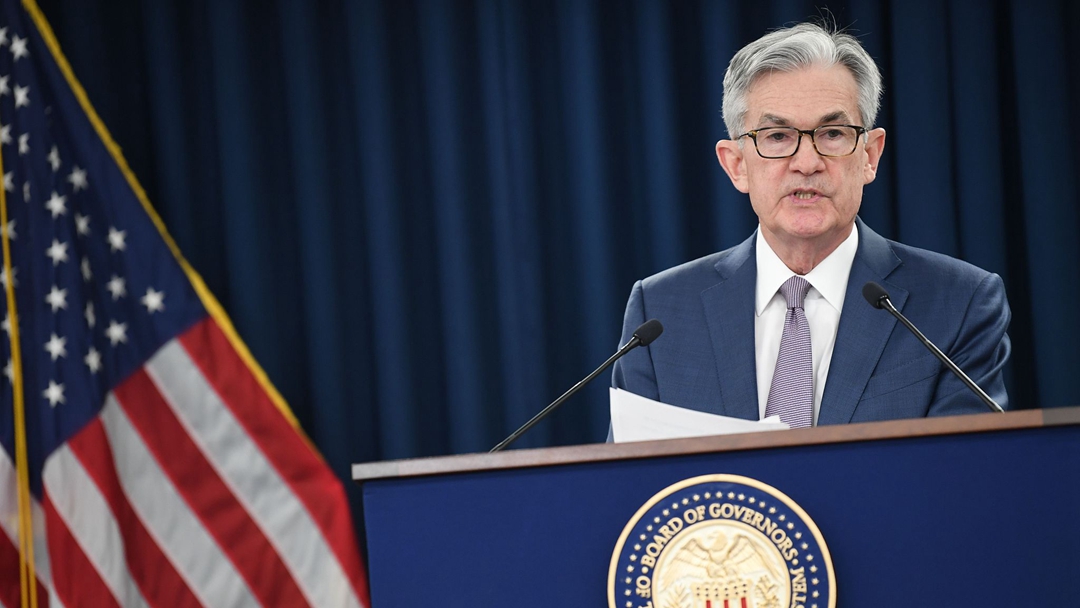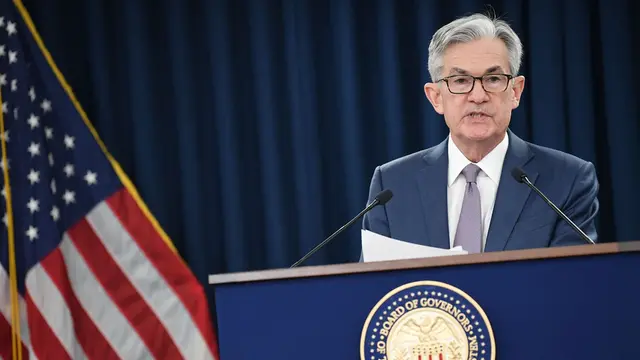
File photo of U.S. Federal Reserve chairman Jerome Powell addresses a press conference, March 3, 2020. /CFP
Editor's Note: Jimmy Zhu is chief strategist at Fullerton Research. The article reflects the author's opinion and not necessarily the views of CGTN.
The Federal Open Market Committee (FOMC) March meeting successfully eased the investors' fear on Fed to tighten earlier than previous forecasts. Bonds yield dropped, and stocks gained after the Fed's policy meeting. Near-term risks for the stock markets are seen to be mitigated, but the steepening curve and the potential rising dollar remain to be the issues that may spur the volatility to rise in the future.
Even with a brightening economic outlook presented by the Fed overnight, the central bank ingeniously used the inflation forecast to ease the recent fears in the financial market. Its median expectation is for inflation to accelerate to 2.4 percent this year, versus the projection of 1.8 percent in December last year. But officials expect inflation to slow to 2 percent in 2022 and 2.1 percent in 2023, showing the Fed tries to convince the market that the expectations on inflation to persistently rise is not likely to happen.
Investors cheered on such forecasts, Dow and SP 500 indices hit another record high after the policy statement. Last year, the Fed tweaked its policy framework that it would allow inflation to shoot above 2 percent for some time before tightening the policy. Previously, its monetary policy leaned toward a more preemptive approach – tightening the policy to prevent inflation to persistently rise above its target level.
The February core consumer price index stood at 1.3 percent, showed that the current level of inflation is still well below the Fed's 2 percent target. Given there won't be any key economic data to be released in the U.S. in the next two weeks, fears in the stocks and bonds market may continue to ease, and many traders may decide to chase the rally.
The majority of the Fed officials still expect to hold policy rates near zero through 2023, according to updated economic projections released Wednesday. However, traders should pay attention to one minor change in the FOMC statement overnight, as the trend may become a major risk for the market later on. Now seven members expect to start lifting rates in 2022 or 2023, versus five in December.
The issue is, whether, in the future, there will be more officials predicting the rate hike to come earlier, as the economic condition keeps improving. If it happens, it might trigger another round of "taper tantrums" in the financial market. The U.S. 10-year government bond yield just modestly declined after the FOMC meeting overnight, now standing around 1.66 percent, near its highest level in 13 months around 1.69 percent. The price moves in the bonds market show that traders remain quite cautious even with a dovish Fed.
Biden administration's $1.9 trillion stimulus is yet to reach the economy, but its anticipated impact shouldn't be ignored. The size of the bill is around 9 percent of the entire U.S. GDP in 2019. If the mega stimulus substantially boosts growth, even just for a short period of time, bond yield is expected to rise again. Given the current high valuations for the U.S. stocks, traders' will to re-access the pricing would be justified if yield keeps climbing while the growth outlook remains uncertain.
Again, Powell didn't address any specific strategy of how the Fed is going to tackle the rising borrowing cost. Though the current levels of the yield of the bond are far from enough in prompting the Fed to take action, moves in yield remain one of the most important factors in driving the sentiment in the financial market. Having that said, if the economic condition further improves from here, Powell will face a much more difficult time in the coming policy meetings.
On the other hand, the rising dollar is another risk for the financial market as it would tighten the financial condition. Since the pandemic happened in the first quarter last year, moves in the dollar have been persistently in an inverse correlation with the stocks market. The European Central Bank (ECB) announced last week its commitment to implement more policy easing in the second quarter, the policy divergence between the Fed and ECB may lead to a stronger dollar if the euro weakened.
The global economy is still at an early stage of recovery since many growth activities were forced to suspend in order to slow the spread of the virus. Uncertainties always stay high in this cycle, low-rate and the cheap dollar are more important to boost the investors' confidence than many other factors before the economic condition is strong enough to offset the negative impact from higher rates. Thus, the financial market's volatility may not be smooth in the second quarter as the Fed is likely to find it difficult to ease the market fears again.
 简体中文
简体中文





